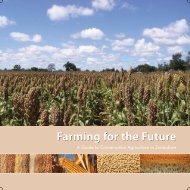Restoring the Soil - Canadian Foodgrains Bank
Restoring the Soil - Canadian Foodgrains Bank
Restoring the Soil - Canadian Foodgrains Bank
You also want an ePaper? Increase the reach of your titles
YUMPU automatically turns print PDFs into web optimized ePapers that Google loves.
Annex 2: The Evidence85content of a soil. First, <strong>the</strong>y do not measure <strong>the</strong> phosphorus that is tied up chemicallyand <strong>the</strong>refore is unavailable to plants. Secondly, <strong>the</strong>y do not measure <strong>the</strong> phosphorusthat exists in organic forms, whe<strong>the</strong>r that be in decomposing plant material or in soilfauna and flora. Fur<strong>the</strong>rmore, <strong>the</strong>se inaccuracies may be quite large, leaving out alarge majority of <strong>the</strong> total phosphorus present in <strong>the</strong> soil.During a study I did in Africa in late 2009 for <strong>the</strong> Christian Reformed World ReliefCommittee, I traveled through significant areas of Malawi, Zambia, Kenya, Uganda,Niger and Mali, interviewing farmers wherever I visited. When doing such studies,I observe all <strong>the</strong> agricultural practices and conditions that I can as I travel along <strong>the</strong>highways and dirt roads in order to triangulate that information with what I see insmallholder farmers’ fields and hear from <strong>the</strong> farmers. I saw tremendous evidencethat yields were diminishing, primarily because of nutrient deficiency. But nitrogenwas clearly most deficient in at least 95% (probably closer to 98%) of <strong>the</strong> tens ofthousands of fields that I observed. Nitrogen deficiency is due to a lack of organicmatter in <strong>the</strong> soil. All over Africa, farmers are mining <strong>the</strong> nitrogen out of <strong>the</strong>ir soils.Wherever one goes, one can observe <strong>the</strong> yellowish, stunted maize and millet fields thatindicate a nitrogen deficiency. On <strong>the</strong> o<strong>the</strong>r hand, <strong>the</strong> purple leaves and stems associatedwith phosphorus deficiency were visible on less than 5%, and probably closer to2%, of <strong>the</strong> fields.Something is obviously wrong with <strong>the</strong> CGIAR’s prediction of a major phosphorusbasedcrisis within <strong>the</strong> next decade or so. But why such a striking lack of phosphorusdeficiency symptoms? Deficiency symptoms in most grasses like maize and millettend to indicate only <strong>the</strong> single element that is most limiting. That is, if a nitrogendeficiency is more limiting to <strong>the</strong> plant’s growth than a phosphorus deficiency, youwill see only <strong>the</strong> symptoms of nitrogen deficiency on <strong>the</strong> leaves or stems of <strong>the</strong> plants.So my observation of fields around Africa did not indicate that <strong>the</strong>re was no phosphorusdeficiency. Ra<strong>the</strong>r, it indicated that in a widespread, consistent pattern, <strong>the</strong> soil’sphosphorus deficiency (if present) was masked by a worse nitrogen deficiency.This consistent masking of whatever phosphorus deficiency <strong>the</strong>re was—across a wholecontinent—leads me to believe <strong>the</strong>re must be some relationship between <strong>the</strong> availableamounts of <strong>the</strong> two nutrients, causing <strong>the</strong> phosphorus deficiency to be consistentlyless limiting than <strong>the</strong> nitrogen one.If <strong>the</strong> original amount of phosphorus in <strong>the</strong> soil and subsoil minus <strong>the</strong> amount takenout by African farmers over <strong>the</strong> years were <strong>the</strong> main factor in determining <strong>the</strong> amountof available phosphorus, <strong>the</strong>re would be no relationship between that quantity ofphosphorus and <strong>the</strong> quantity of nitrogen in <strong>the</strong> soil. There would, <strong>the</strong>refore, tend tobe many fields in Africa with <strong>the</strong> purplish signs of phosphorus deficiency. However,if <strong>the</strong> amount of organic matter in <strong>the</strong> soil were <strong>the</strong> main determinant of how muchphosphorus was available to plants, <strong>the</strong>n a very clear relationship would exist. In <strong>the</strong>absence of chemical fertilizer, <strong>the</strong> amount of nitrogen in a soil correlates quite closelywith <strong>the</strong> amount of organic matter, which in turn would correlate quite closely with<strong>the</strong> amount of available phosphorus in <strong>the</strong> soil.
















